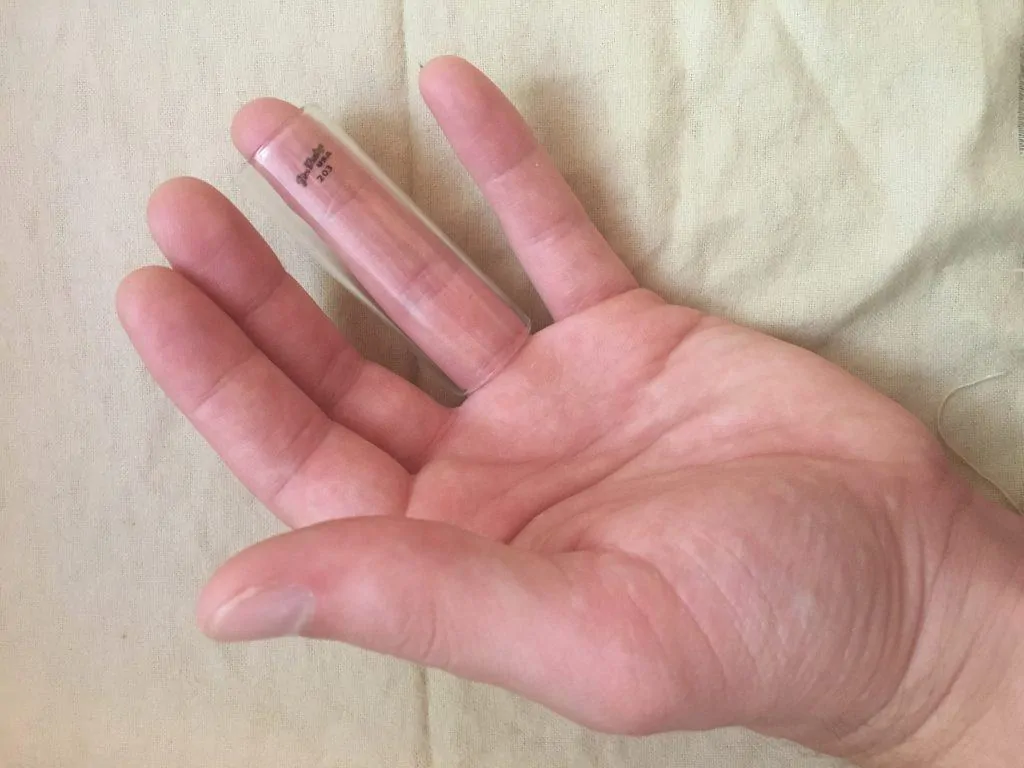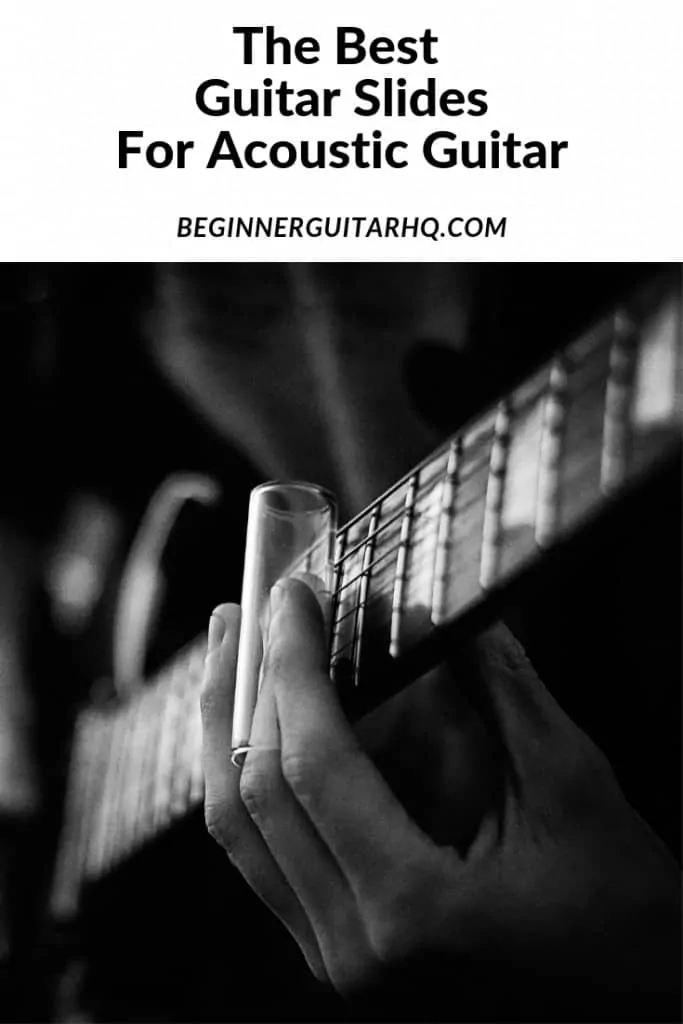Guitar slides started as a part of Hawaiin culture and heavily influenced Delta Blues in the United States. And now, they’ve changed the faces of current blues, rock, and country music. So for a long time, people have debated what the best guitar slides are.
And we’d like to enter that debate, acoustic style.
Here’s our take on the best guitar slides for acoustic guitar, plus a bit about the different types and tips on how to choose the right one for you.
The Different Types Of Guitar Slides
It’s important to know the different types of guitar slides
There are many different types of guitar slides for acoustic guitar made of varying materials. They can be glass, brass, steel, or ceramic, each giving you a slightly different sound.
Glass Guitar Slides
Glass is the oldest and probably most used type of material in guitar slides. It’s soft, light, a short sustain, and may have the warmest tone out of all the types.
The big downside, however, is that glass is fragile. Drop it and it will probably break. You can get a slide that’s made of thicker glass, but you’ll still need to be careful with it.
Steel And Brass Guitar Slides
Steel and brass slides are both a type of metal and will give you similar sounds. They’ll both have a bright sound and a longer sustain, but some acoustic guitarists don’t like their harshness. Electric guitarists are the ones who usually prefer brass or steel. Brass is going to be a bit darker sounding than steel and also a little louder.
Ceramic Guitar Slides
If you’re looking for something with a longer sustain than glass but not as harsh as metal, ceramic is a good option. It gives you the best of both worlds, in tone, brightness, loudness, and sustain.
The only problem is that ceramic can be more fragile than glass, so you’ll have to be extra careful. But if you’re a beginner guitarist and you’re not sure which style to pick, ceramic is a safe bet.
How To Choose The Right Guitar Slide
When it comes to choosing the right guitar slide for you and your acoustic guitar, there are a couple things to consider.
First, you need to figure out which finger you’d like to wear the slide on. And then you’ll need to find a slide that fits that finger best. Starting out, you may find the ring finger to be comfortable, but at some point it, you should switch to the pinky finger. This allows you to have your first three fingers to be open for playing chords.
Whatever finger you use, you want the slide to fit over the first two joints of your finger but not be too tight. It needs to stay on if your hand hangs downward and you shouldn’t need your other fingers to keep it on while playing.
The length of the slide should be able to go across the whole fretboard without being too much longer than the fretboard. It may be difficult to find a perfectly sized slide, so just get as close as you can.
The second consideration is the weight of the slide. Heavier slides tend to be louder, have more sustain, produce less string buzz, and have warmer tones. However, heavier slides may be harder to move around and use properly. If the action on your guitar is low or you’re using light strings, a heavy slide may make contact with the fretboard too much.
The Overall Best Guitar Slides For Acoustic Guitar
Now that you know the different types of guitar slides and how to choose the right one for you, here are the best guitar slides for acoustic guitar that we could find. On this list, you’ll see a mixture of glass, brass, steel, and ceramic slides.
Ernie Ball Glass Guitar Slide
Ernie Ball has several types of guitar slides, but the best of theirs is the glass slide. They make it from “borosilicate glass,” which is apparently more durable than other glass slides. Its surface is smooth, making it easy to move across the strings, and it has a smooth and clear tone.
It comes in three lengths, depending on your guitar and playing style: 48mm, 58mm, and 69mm.
Dunlop Glass Slide
The Dunlop glass slide delivers a warm and thick tone that shows off the mid-range harmonies of your guitar. It comes in ring sizes from 8-13, the bigger the ring size, the longer the slide. The length can range from 57mm to 70mm.
D’Addario Planet Waves Glass Slide
Each D’Addario Planet Waves glass slide is heat-treated individually so the edges stay smooth and the surface is finished perfectly. This allows the slide to move across the strings with ease while giving you a warm and thick tone.
The ring sizes range from 7.5-11 and the lengths available are 48mm, 51mm, and 60mm.
Dunlop Moonshine Ceramic Guitar Slide
Each of these ceramic guitar slides is hand-formed and meant to last for years and years, even with heavy use. It offers a full and rich sound that resonates and sustains. Plus, it’s made of porous material, which helps your finger breathe and prevents the slide from slipping off.
The available ring sizes range from 7-9 and the length ranges from 55mm to 59mm.
Clayton Brass Socket Guitar Slide
Steve Clayton basically took the idea of a tool socket (like one you’d use with a ratchet) and made what’s called a socket guitar slide — musicians had already been using tool sockets as slides. He balanced out the weight and made the whole thing lighter, but he kept the interior shaped in a 12-star design for the best grip possible.
The ring sizes range from 6 ¾ to 12 ¾.
Dunlop Derek Trucks Medicine Bottle Guitar Slide
The name of this guitar slide means what you think it means — it’s shaped like the top of a medicine bottle. Because of this, it gives you a bright and crisp tone. And the weight is well balanced because of the heavier top.
The only ring size available is 12, which means it’s 68mm long.
Final Verdict
Each acoustic guitarist has their own preference and slide-playing style, so you may already know exactly which of these slides you want. But if you’re on the fence, I’d recommend the Clayton Brass Socket Guitar Slide.
Heavier slides are best for acoustic guitars, meaning brass is a good option. And the Clayton slide has an interior grip to keep it on your finger. Plus, there’s a decent range of ring sizes and length.
Let us know in the comments which one you like best!

Caleb J. Murphy is a songwriter, composer, and multi-instrumentalist based in Austin, Tx. He’s been playing guitar since 2002, writing songs since 2005, and producing music shortly after that. After getting a few (unofficial) basic guitar lessons from his brother, he taught himself guitar the rest of the way. Since then, he tries out any instrument he can get his hands on, like piano, banjo, ukulele, and cheap keyboards from the 90s.


